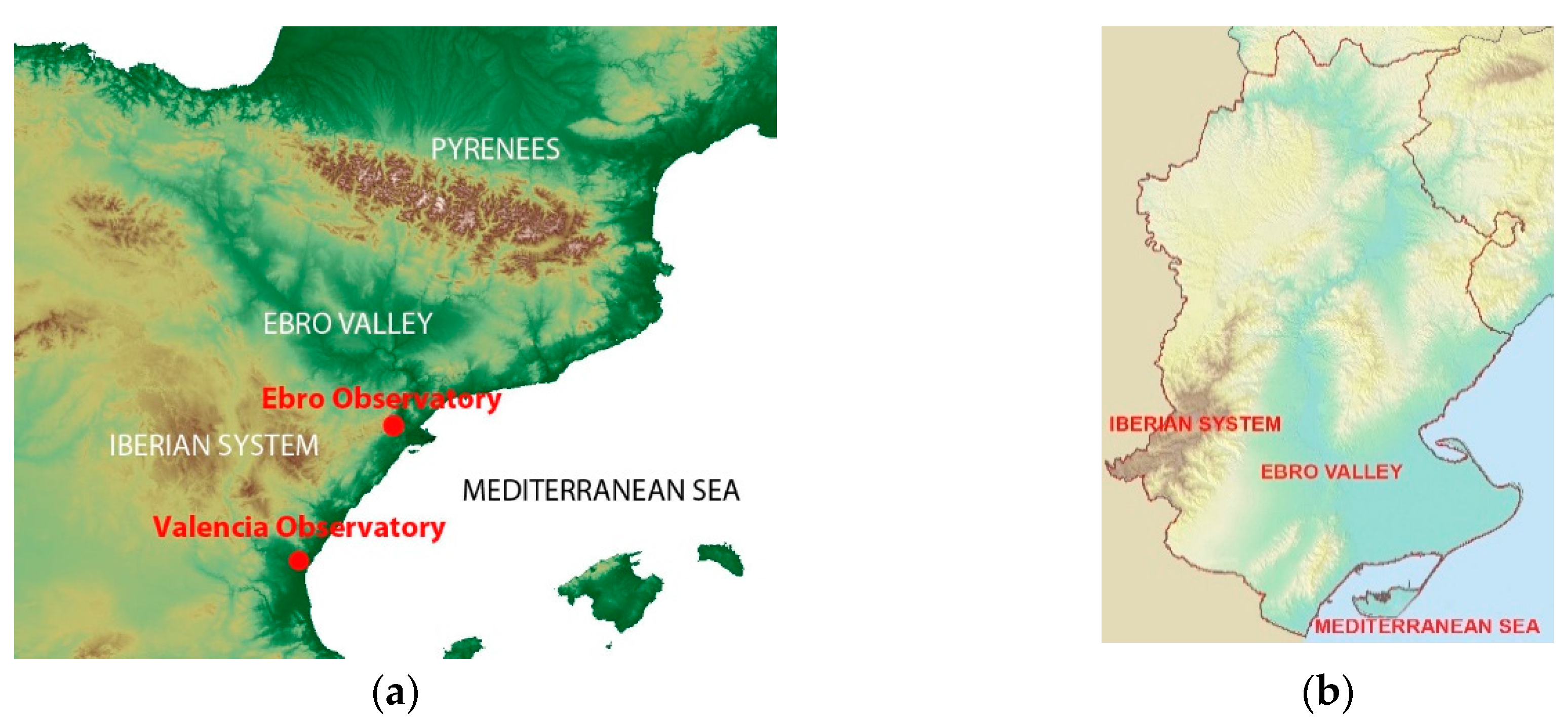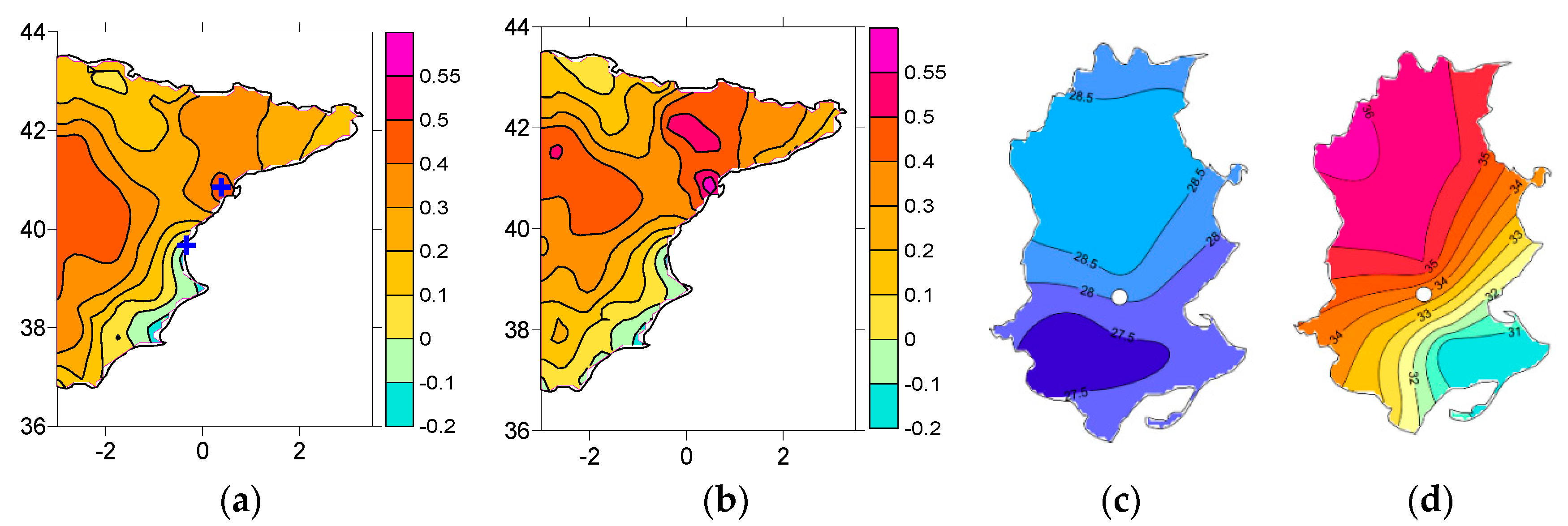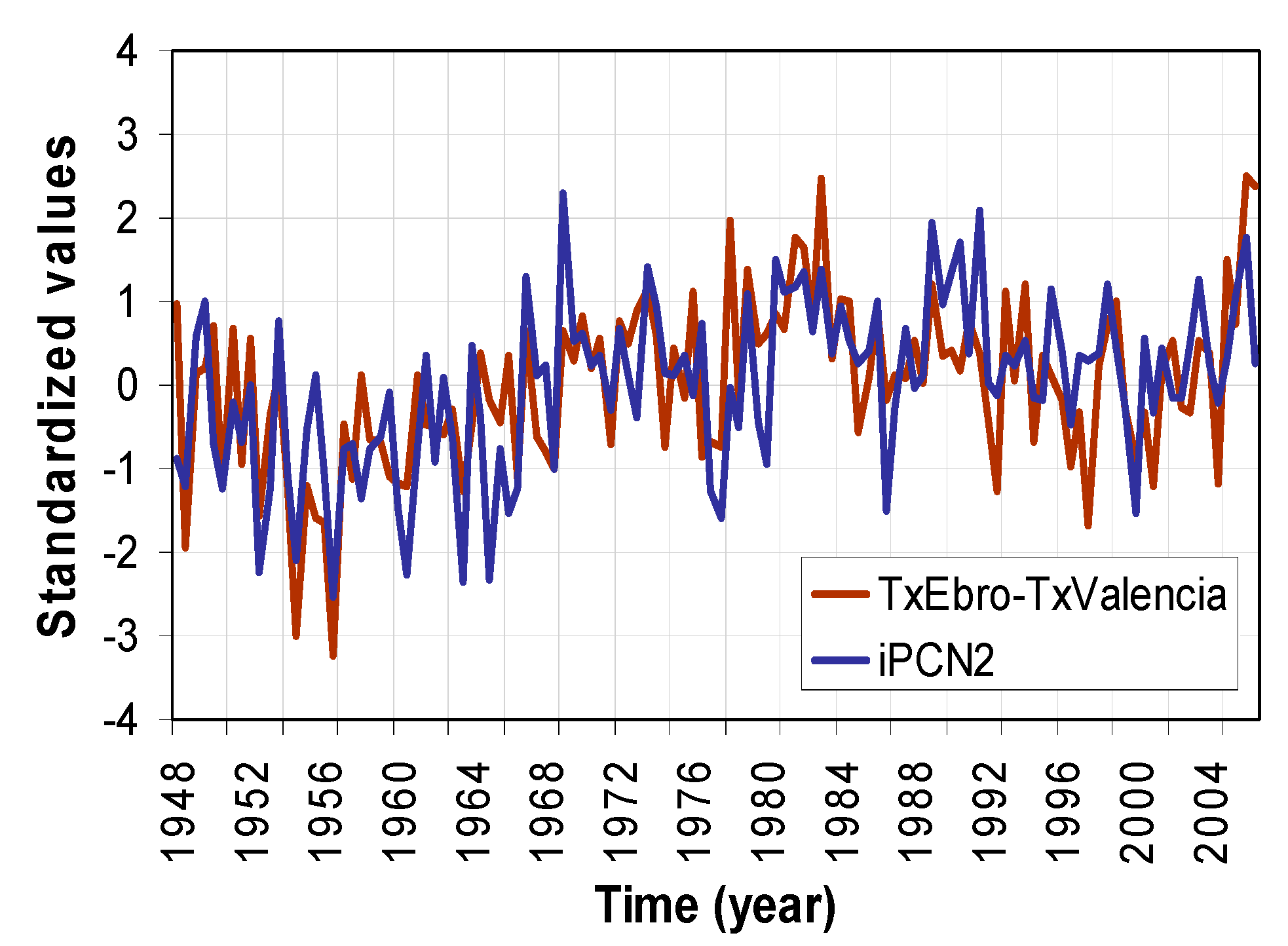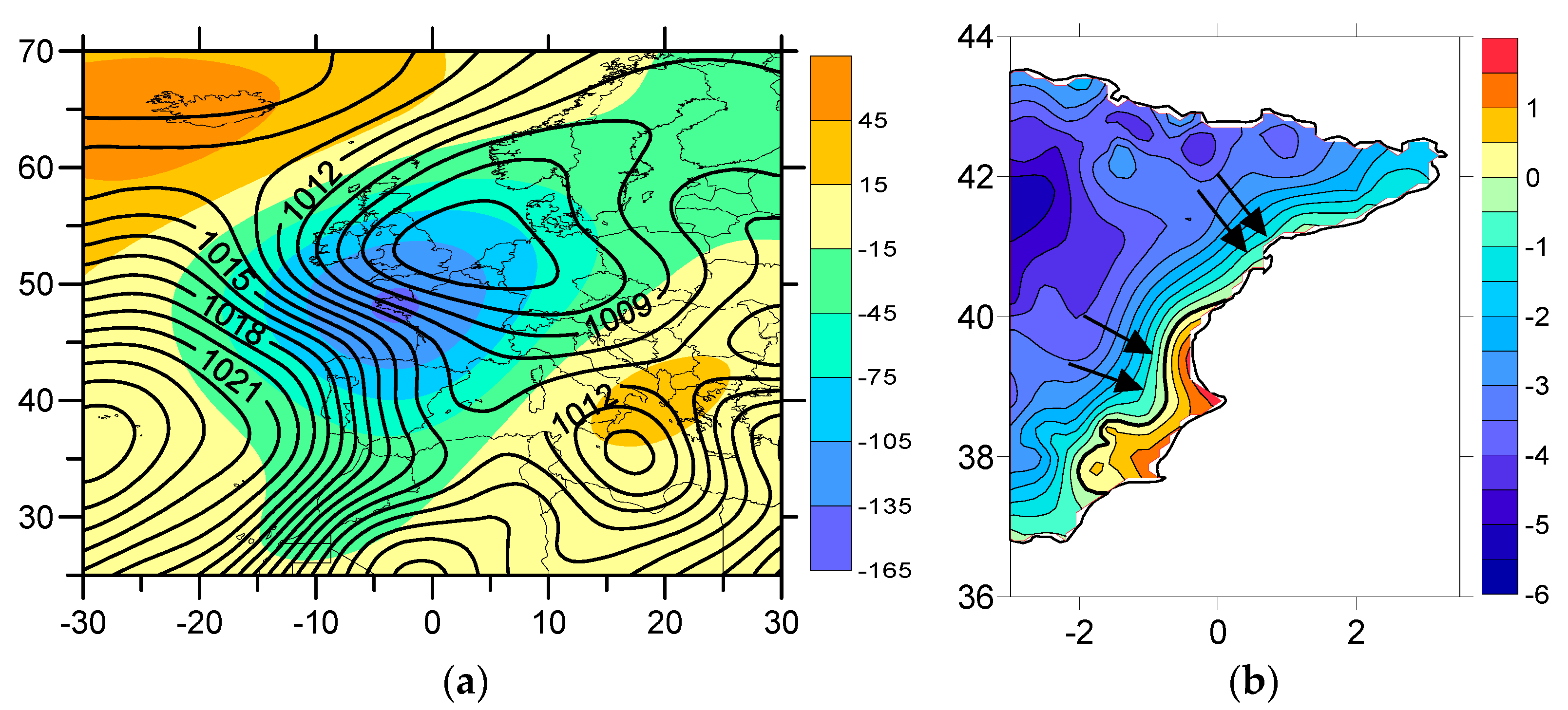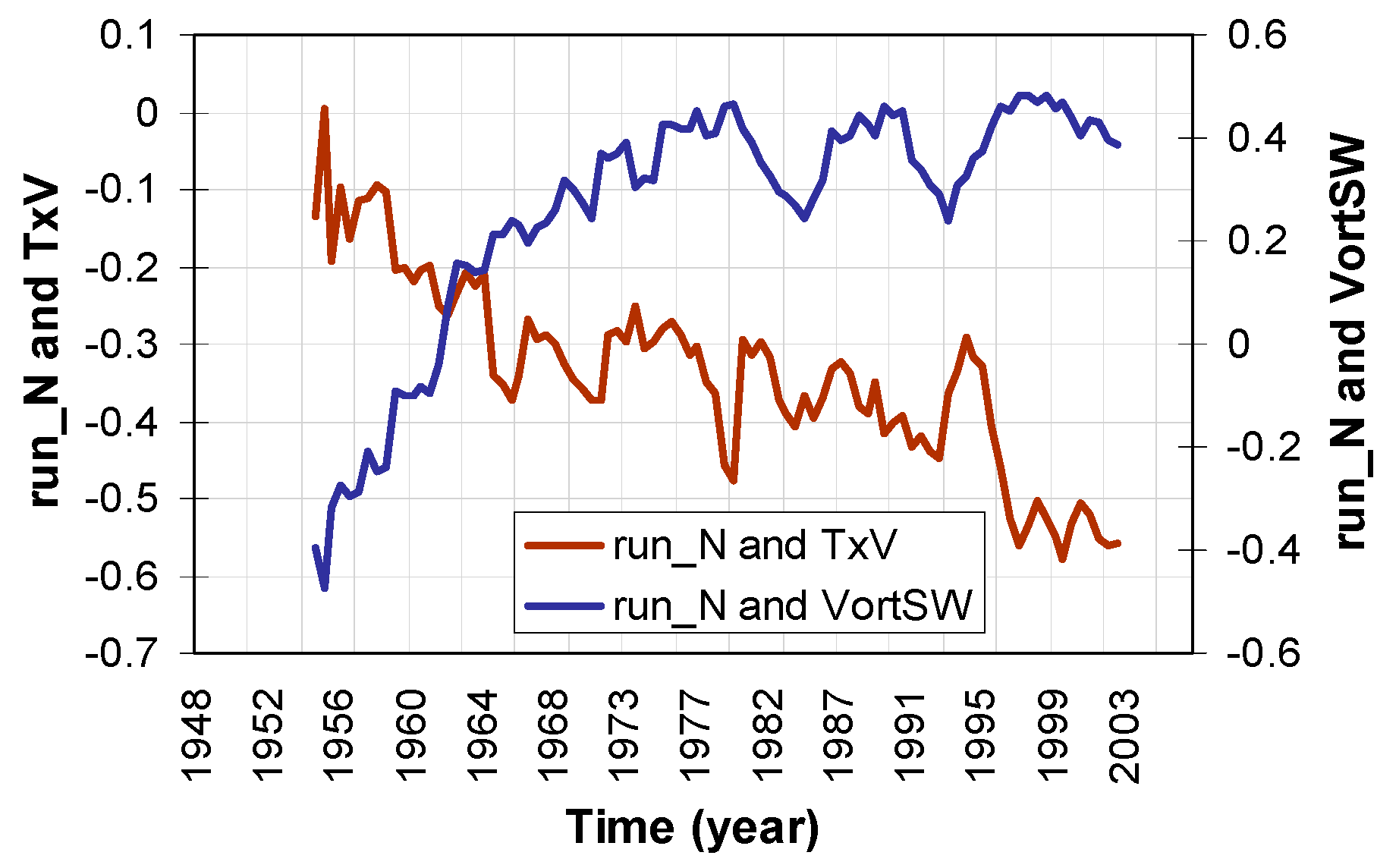1. Introduction
The 20th century saw a worldwide rise in temperature of 0.89 °C [
1] but this increase was not a uniform one all around the globe, neither spatially nor seasonally [
2,
3]. Actually, this increase was not a progressive one either and was, in fact, produced during two different phases. The first one lasted from 1910 to 1945 [
4], while the second—and much more significant—phase has lasted from 1976 onward. From 1950 to the 1970s, a slightly negative trend was recorded. On the other hand, minimum temperatures increased at a faster rate than maximum temperatures during the latter half of the 20th century resulting in a significant decrease in the DTR (diurnal temperature range) for this period [
5]. Furthermore, this widespread decrease in the DTR was only evident from 1950–1980 [
6]; that is to say, maximum and minimum temperatures have increased roughly at the same rate from the beginning of the current period of global warming.
There are many studies which indicate that the temperature evolution in the Iberian Peninsula (IP) is analogous to the evolution of temperatures worldwide. For example, Brunet et al. [
2] detected two periods of rising temperature (1901–1949 and from 1973 onward) and another period with a fall (1950–1972). In Spain, the most remarkable feature of the twentieth century was an abrupt and strong warming recorded from the early 1970s onward [
7,
8,
9,
10]. Furthermore, the results of the majority of studies regarding changes in Spanish temperatures during the 20th century show that maximum temperatures (Tx) increased at greater rates than minimum temperatures (Tn) both over the whole mainland [
11,
12] and over several sub-regions [
13,
14,
15,
16]. During the period 1901–2005, Tx have increased by twice as much as Tn [
2] on average. However, this long-term asymmetry between maximum and minimum temperatures was clearly broken in the period 1973–2005 [
2]—a result which is in agreement with the corresponding worldwide temperature behaviour for that period [
6].
In the Valencia region (the eastern-central part of the IP, on the Mediterranean coast) Miró and Estrela [
17,
18], found a much more significant increase in minimum summer temperatures (July and August) compared to the increase in maximum temperatures at the coastal and pre-coastal observatories in the period 1958–2003. In their study, the authors only selected stations away from heavily urbanized areas in order to prevent the urban heat island effect. Moreover, at the inland stations, the trends of maximum and minimum temperatures evolved in a similar way. They found a stronger increase of maximum temperatures at the inland stations when compared to the increase seen at those on the coast and a notable SST (sea-surface temperature) increase in August which can be reflected in the stronger increment of temperature in August in comparison with July. The combination of this warmer sea with a greater predominance of tropical air masses has been discussed by the authors as the causes of the drop observed in the thermal oscillation in the coastal areas. However, that explanation is not entirely consistent with the fact that the main DTR drop in the littoral and pre-littoral areas occurred before 1980 (Figures 11 and 12 in Miró and Estrela [
18]) well before the current period of climate change became evident. In fact, the DTR drop recorded from 1980 onwards is very small in July and negligible in August.
On the other hand, Quereda et al. [
19] related the differential behaviour of Tx in comparison with Tn (i.e., the fall in DTR) seen at the main observatories of the coastal area of the Valencia region in the second half of the 20th century to urbanization because this asymmetry has not been found in the respective trends of the rural observatories’ time series. Furthermore, Quereda et al. [
20] estimated that the magnitude of the urban heat island effect could account for between 70% and 80% of the recorded warming trend in Western Mediterranean cities.
Moreover, while the DTR fell in the coastal area of the Valencia region, at the same time the DTR rose quickly at the Ebro Observatory, only a few hundred kilometres to the north. We believe that, despite the fact that the effects of urbanization on the negative trends of the DTR in the central and southern part of the Mediterranean area of the IP may be significant, this differential evolution of Tx trends in comparison with Tn trends is also related to the strong positive trend of the DTR recorded at the Ebro Observatory. Both asymmetric DTR trends can be partly explained by a different reaction—on a regional level—to changes in atmospheric circulation on a synoptic-scale in the North Atlantic.
There are various factors which can contribute to temperatures recorded in different regions evolving differently. Favà et al. [
21] found a differential behaviour of Tx trends in the NW IP (positive) compared to those in the SE IP (negative) in the months of summer (July and August), which was related to the strong increase in the SNAO recorded at the end of the 1960s [
22]. The SNAO is the first EOF obtained from a matrix of covariances of the North Atlantic sea level pressure anomalies [
23]. The SNAO index is strongly linked to temperatures and precipitation in the north and west of Europe although its influence on southeast Europe is slightly lower and in the opposite sense. In the IP, the correlation between SNAO and precipitation is of positive sign (with the exception of the NW), as in SE Europe, Italy and the Balkans [
24].
The main goal of this work is to determine, from the atmospheric circulation, the principal synoptic structures related to the increase in the Tx and DTR in the Ebro Observatory region in comparison with the same variables further south. With this aim in mind, after identifying these structures, we studied whether possible changes in their frequency can help to explain the differential behaviour of the Tx and DTR trends around the Ebro Observatory region in comparison with the east and southeast (SE) IP region.
The paper will be structured as follows. The data used and the proposed methodology are presented in
Section 2. In this section, the relationship between the wind and the pressure gradient on a synoptic-scale at the Ebro Observatory is also studied to justify the sorting of data into ‘Northern days’ and ‘Southern days.’ In
Section 3 we study the relationship between the relative vorticity at sea level and maximum temperatures at the Valencia Observatory. In
Section 4 we propose an index based on the atmospheric circulation related to the difference between the maximum temperatures recorded at the Ebro Observatory and those of the Valencia Observatory. The results are presented in
Section 5 and finally we present the discussion and conclusions.
3. The Relative Vorticity at Sea Level and the Temperature at Valencia Observatory
After investigating which variables of the atmospheric circulation field may give us more information about the difference we can expect to find at a specific moment between the Tx and DTR anomalies of the areas around the Ebro Observatory and Valencia Observatory, we found that the relative vorticity at sea level plays a significant role in the sense that it allows us to describe easily how the surface pressure gradients will be distributed along the eastern IP coast. These pressure gradients are determining factors to shift the balance for the regional conditions of both observatories towards continental air or marine air (the Valencia one is located on the coast, while the Ebro Observatory is on the pre-coast—a little inland).
We calculated the relative vorticity (
ζ) at each grid point in the window (30° W–30° E, 25° N–60° N) by firstly computing the approximate components of the theoretical geostrophic wind at sea level (
u,
v), setting out from the sea level pressure gradient (
), the Coriolis parameter (ƒ = 2Ω·sinØ, where Ω is the angular speed of rotation of the earth and Ø is the latitude) and the sea level air density (
ρ) [
31]:
We found that both the Tx and the DTR at both observatories—but especially at Valencia—can be related with the way the relative vorticity is distributed at sea level. At Valencia Observatory, owing to its geographical location, the (marine/continental) wind direction has a direct relation with the Tx and DTR; on average, the westerly wind due to its run over the inland IP, is warmer than the wind from the east (which has followed a marine route). At the Ebro Observatory, this relationship becomes more complex, though, partly due to the orographic conditions.
We studied how the differences between the relative vorticity of any random pair of points and the time series of Tx at the Valencia Observatory (TxValencia) correlate. The map in
Figure 2 shows the spatial distribution of the maximum values of the former correlations and indicates that the pair of points for which the difference between their relative vorticity values correlate as closely as possible with TxValencia are (7.5° W, 37.5° N) and (2.5° E, 42.5° N). To draw up this map we looked at all the points, searching for the maximum possible absolute value of the correlation between the relative vorticity difference at each point with respect to any other point and the TxValencia time series. First, we calculated the sea level relative vorticity at each point; then we combined the first point with all the others in order to obtain a matrix of values corresponding to the difference of relative vorticity between the first point and all the others. Then we computed another matrix from the absolute value of the correlations between the elements of the former matrix and TxValencia. Finally, we selected from that matrix the maximum absolute value, which is the value plotted in
Figure 2 corresponding to the first point. This procedure was applied to all the other points.
This map shows very high values for the correlations at most points—which is not surprising given that for any specific point it is likely that we can find another one where, when subtracting their relative vorticities, we can relate the value obtained from the subtraction with TxValencia merely by chance. However, the areas of maximum correlation have to be paired between themselves in the sense that only the points in these zones have been used to obtain such high correlation values. In these cases, the high correlation values cannot be obtained by chance due to their convergence to two well-defined spatial regions (NE IP and SW IP). There must be a physical explanation for this spatial convergence that we shall look at later.
We called the relative vorticity of the point with maximum correlation in the NE (2.5° E, 42.5° N) ‘VortNE’ and the corresponding relative vorticity in the SW (7.5° W, 37.5° N) ‘VortSW’ (the centres of the red-coloured regions of the map of
Figure 2).
Wind direction is measured in degrees clockwise from the geographical north as seen in
Table 1. The wind direction of the first quadrant is between 0° and 90°, the second quadrant wind is between 90° and 180° and so on until the fourth quadrant.
4. Calculating the Synoptic Patterns Related to a Maximum Differentiation between Tx and DTR in the Ebro and Valencia Regions
Although the former relative vorticities (VortSW and VortNE) are more related to Valencia Tx than Ebro Tx, they could play a part in explaining the differential behaviour between both observatories. However, owing to their proximity, it is quite probable that most of the synoptic situations generate patterns of Tx anomalies with the same sign in both regions. For example, a warm advection centred in the eastern IP will make Tx rise all along the coast. The signal we are searching for will probably be hidden behind the kind of weather common to both areas.
To obtain the synoptic patterns we are searching for, we used a Principal Components Analysis (PCA) with the following daily variables for the period 1948–2006 corresponding to the Northern days, after eliminating the trend:
The relative vorticities of the points with maximum correlation: VortNE and VortSW.
Tx and DTR at Ebro and Valencia Observatories.
Temperature at 850 hPa (T850) in the grid point closest to the Ebro Observatory and to Valencia Observatory (40° N, 0° E).
We used the NCAR Command Language [
32] to compute the PCA. We included the T850 in the PCA to determine whether the anomalies obtained at both observatories have a relationship with the anomalies in temperatures at mid-levels on a synoptic scale or, on the contrary, if they are due to lower scale processes.
On the other hand, the summer IP Tx and DTR are positively correlated to the sunshine duration [
33]. We found strong correlations specifically between DTR and sunshine duration at the Ebro and Valencia Observatories (r = 0.57, > 99% and r = 0.41, >99% respectively, with daily data in the period 1972–2006). However, we did not include the sunshine hours data in the set of variables selected for the PCA because we did not find any significant trend in the sunshine duration for the period 1954–1981 (when the differential behaviour of both Tx trends is at its maximum) at the Valencia Observatory and because the sunshine duration data at the Ebro Observatory is only available from 1972 onwards.
Figure 3 shows the correlations of the seven entry variables of the analysis with the first and the second principal components (PC1 and PC2, which account for 65% of the total variance of the set of the seven variables). This graph shows how the structure linked to PC1 corresponds to a weather pattern which generates a homogeneous behaviour at both observatories with respect to both the Tx anomalies and the DTR ones. Although the structure linked to PC1 explains the greater proportion of variation (44%), we focused on the structure linked to PC2 as it adjusts exactly to what we are searching for: changes in vorticities (VortNE, VortSW) linked to a considerable increase in the Tx and DTR at the Ebro Observatory and at the same time to a discrete drop in the Tx and DTR at the Valencia Observatory. Therefore, PC2 is related to a weather pattern linked to important deviations in Tx and DTR anomalies at both observatories. The correlation obtained between PC2 and the difference TxEbro–TxValencia is very significant (r = 0.72, >99%).
The correlation map of
Figure 4a shows the spatial distribution of correlations between Tx and PC2 and the corresponding map of
Figure 4b shows the correlations between DTR and PC2. On days when the PC2 reaches very negative values, the Tx of the lower Ebro Valley are low and there is a weak cross-shore temperature gradient (
Figure 4c) owing to the homogenizing effect of the cold northerly wind which, as we shall see, is linked to the negative phase of the PC2. On the contrary, for high values of PC2, both the Tx and the towards-inland cross-shore temperature gradient experience much higher values (
Figure 4d).
The result of this PCA shows structures which combine anomalies obtained directly from the observation in both regions with anomalies of variables of the atmospheric circulation field on a large scale and therefore these structures have to be seen on a synoptic-scale. On the other hand, an important difference to be pointed out between the two structures we find is that, in the case of the first one (EOF1), the Tx and DTR at both stations share the same behaviour and also have the same behaviour with respect to T850. This confirms that the positive (negative) anomalies are in this case due to a large scale synoptic situation associated with a warm (cool) advection and that this probably affects all the eastern IP area. In the case of the structure linked to PC2, though, the T850 does not show any correlation, which suggests that the Tx and DTR anomalies in this case are due to a process with a more regional scope.
Another important conclusion that can be inferred from the PCA is the fact that, while at the Ebro Observatory it is possible to find synoptic structures related to high absolute values of Tx and DTR regardless of the sign of the difference (VortNE-VortSW), this is not the case for the Valencia Observatory. In general, the main way to find significant positive (negative) anomalies of DTR and Tx at the Valencia Observatory is when the difference VortNE-VortSW is positive (negative). This is a result of the geographical location of Valencia: when VortNE-VortSW is positive, the direction of the wind to be expected is from the fourth quadrant, which is warmer than on average because of the air heating related to its crossing of the IP under high insolation conditions and to the adiabatic compression due to the loss of altitude. When VortNE-VortSW is negative, the opposite effect occurs: then the direction of the wind to be expected is from the second quadrant, which, in general, is cooler than on average as a result of the mild sea air. This is true not only for Valencia but for all the SE coast in general. This singularity of the Tx in the Valencia region with regard to the relative vorticity explains the correlations map of
Figure 2.
Our aim is to study the time series of PC2 so as to evaluate its possible relationship with the differential behaviour of the Tx along the east IP coast. Also, we are interested in the time series of PC1, because it is the leading principal component and, hence, a large percentage of variance is linked to it. However, the time series of PC1 and PC2 contain direct information regarding the Tx and DTR of both stations (Ebro and Valencia) and it would not make sense to try to explain the increase of the Ebro DTR and the decrease of the Valencia DTR, from indices which already contain direct information about these variables. For this reason, we calculated two new indices (iPCN1 and iPCN2) from data which only come from the NCEP reanalysis: Z500, MSLP, Z500-Z1000 and sea level relative vorticity.
On the other hand, it is important that the new indices ‘inherit’ the links of the original indices with the PCA entry variables (
Figure 3) (VortNE, VortSW, TxE, DTRE, TxV, DTRV); this way, the information obtained from the PCA will be preserved as much as possible. With the aim of achieving the maximum possible correlation between the new indices (iPCN1, iPCN2) and the original ones (PC1, PC2), we calculated the new indices by using the same procedure as Favà et al. [
29].
The time series of these new two indices (iPCN1 and iPCN2) are computed exclusively from reanalysis and correspond to well-defined spatial structures. In order to compute the iPCN1 index, we selected the days with extreme values (higher than the 90th percentile) corresponding to the positive phase of PC1. Using this days, we then calculated the patterns of normalized anomalies corresponding to the fields of sea level pressure (MSLP), geopotential height 500 hPa (Z500), thickness (Z500–Z1000) and sea level relative vorticity in the window (30° W–30° E, 35° N–60° N). In this study, the relative vorticity field is needed because, as we have seen, it is closely related to the Tx and DTR at Valencia Observatory.
In order to calculate the normalized anomalies, for each field, we calculated the average value and standard deviation at every grid point (for the study period). Then we calculated the normalized daily anomalies for each point by subtracting the average value of the field at that point from the daily value of the field at that point (one per day) and dividing the result by the standard deviation at that point.
The four patterns of average anomalies corresponding to PC1 were obtained by selecting those days with PC1 values higher than the 90th percentile (n days) and calculating for this set of days, the average values of the anomalies at each point (
p) for each of the four fields (Z500, Z500–Z1000 (thickness), MSLP and sea level relative vorticity):
We obtained the new index iPCN1 by projecting the four former patterns onto the normalized daily field anomalies of MSLP, Z500, Z500–Z1000 (thickness) and sea level relative vorticity in the window (30° W–30° E, 35° N–60° N) (corresponding to 275 grid points) and finally by adding the four obtained values.
The ‘normalized daily field anomalies’ refers to the set of daily values of normalized anomalies corresponding to each of the four fields. For each field, there is a normalized anomaly for each grid point on each of the days of the selected period.
The index iPCN2 was calculated in the same way that iPCN1 but the four patterns of average anomalies corresponding to PC2 were obtained by selecting those days with PC2 values lower than the 10th percentile. We found the best correlations between PC1 and iPC1 and between PC2 and iPC2 projecting onto the normalized anomaly fields the cold phase of the two indices (PC1 and PC2), hence we selected the days with PC1 values higher than the 90th percentile (the cooler days in the IP) and the days with PC2 values lower than the 10th percentile (the cooler days in the IP). By giving more weight to the vorticity (doubling it), we were able to maximize the correlations between these new indices (iPCN1 and iPC2N) and the former ones (0.74 and 0.73 respectively).
In order to check whether the links between the set of PCA entry variables and the new indices we calculated (iPCN1 and iPCN2) are preserved, we calculated the correlations between them and VortSW, VortNE, Tx, Tn and DTR at the Ebro and Valencia Observatories for the period 1948–2006 after removing the trends from all the time series (
Table 2).
We also calculated the correlations between the indices iPCN1 and iPCN2 and the difference between the Tx and DTR at both observatories (TxEV, DTREV) (
Table 2). As expected, the index iPCN2 correlates well with TXEV and DTREV (in contrast to iPCN1) and also with DTRE and DTRV. The time series of both iPCN2 and TXEV are close related (
Figure 5).
6. Discussion and Conclusions
We carried out an initial classification between ‘Northern days’ and ‘Southern days’ setting out from regional aspects regarding the kind of wind to be expected in the region around the Ebro Observatory. This classification is also applicable on a larger scale—particularly over the Iberian Peninsula [
21,
29].
We calculated a PCA from a set of variables which come from the NCEP reanalysis (T850, VortSW, VortNW) and from observation data (Tx and DTR of Ebro and Valencia Observatories) and then we obtained the indices iPCN1 and iPCN2 from reanalysis data (MSLP, Z500, Z500–Z1000 and sea level relative vorticity).
In the positive phase of iPCN2, the north-westerly flow makes the Tx and DTR increase in the lower Ebro valley as it corresponds to a warm anticyclonic situation with clear skies and warm air at high levels. Under these conditions, the Tx in the inland IP increase significantly which make the Ebro Observatory Tx increase as the flow displaces the continental air mass near the coast. But these conditions are, in turn, responsible for a slight fall in the same variables on the SE coast of the IP due to a greater exposure there to northerly air with a maritime route.
The opposite case happens in the negative phase of iPCN2. Here, the temperatures tend to fall inland as these conditions are not anticyclonic ones but correspond to an influx of air from higher latitudes at high levels in combination with northerly wind at low levels due to the presence of a strong westward pressure gradient. This air is much colder than on average at high levels and prevents the maximum temperatures from increasing—especially in the northern part of the IP but not on the SE and Valencia coast where this wind comes from inland (‘ponent’) and is therefore warmer, due to its crossing of the IP under high insolation conditions and to the adiabatic compression due to the loss of altitude. Accordingly, we found at the Valencia Observatory, very significant correlations between the daily westerly wind run (direction from the third and fourth quadrant) and the iPCN2 index and VortSW (r = −0.41, >99% and r = −0.42, >99%, respectively) in the period (1997–2006). The days with westerly wind can register very high temperature levels in the SE IP and Valencia region coast. This explains why we also found a significant correlation (r = −0.21, >99%) between the iPCN2 index and the frequency of days with Tx > Tx90 (90th percentile of the Tx of each station) in the stations of this area.
In the 1950s and early 1960s, during the Northern days (the frequency of which was significantly higher than usual [
29]), the iPCN2 and the SNAO values were frequently negative, restraining maximum temperatures in northern IP due to the northerly flow linked to a marked westward pressure gradient and maintaining a reduced DTR in the area around the Ebro Observatory. However, in the same period, these negative values of iPCN2 and the consequent negative values of the relative vorticity in the SW IP contributed to increasing the Tx and DTR in the area around the SE IP and Valencia region close to the coast and also increased the frequency of days with westerly winds (‘ponentades’). So, we can conclude that in the 1950s and early 1960s, the atmospheric circulation enhanced the frequency of westerly flow and the probability of extreme temperatures in that region. In the 1950s and early 1960s, therefore, the maximum temperatures and DTR at the Ebro and Valencia Observatories showed a certain convergence.
The increase detected in the iPCN2 index from the late-1960s onward contributes to explaining why, from the late 1960s to about 1980, the Tx and the DTR in both regions (Ebro Observatory and Valencia and the SE area close to the coast) showed a greater and greater divergence. The subsequent increase in the relative vorticity in the SW IP decreased the influence of inland winds at the Valencia Observatory and in the SE IP closest to the coast and enhanced the frequency of sea breezes but at the same time the enhanced anticyclonic conditions contributed to increasing the Tx and DTR in the area around the Ebro Observatory. Thus, the general increase in Tx seen at the end of the 20th century related to the current climate change was strengthened in the lower Ebro Valley owing to the shift of the Azores High towards the NE and, at the same time, it was weakened in the littoral and pre-littoral areas of the SE IP.
There are several studies [
17,
18] that show a decrease of the DTR in the SE of the IP in the second part of the 20th century but we disagree with their proposed explanation—in particular due to the fact that the decrease occurs mainly between the 1950s and early 1980s, before the current climate change. These studies assume that the DTR drop could be explained from a rise in the minimum temperatures but we checked that the DTR drop from the late-1960s to around 1980 in the SE IP closest to the coast in summer, is mainly due to a steeper drop in the maximum temperatures than in the minimum ones. Thus, from the 1980s to the beginning of the 21st century, the DTR does not show a significant trend, which is in line with what happens globally [
6].
The steep rise of the iPCN2 and SNAO indices (highly correlated during the period 1948–2006, r = 0.52, >99%) of the late 1960s had two important cumulative effects on the maximum temperatures of the Valencia region and the SE IP: on the one hand, there was a drop in the frequency of days with westerly wind and, on the other, the northern cold advections in summer tended to be more centred on the eastern IP [
29]. The cold advections in the eastern IP are related to blocking situations in northern Europe, which force air at higher latitudes to move to lower latitudes. These blockings are usually related to strongly positive values of the SNAO index. One specific case is that of the cold advections over the Gulf of Lion [
29]. Furthermore, these cold advections were frequently related to an increase in the total cloud cover in the SE of the Iberian Peninsula [
29] which probably also contributed to lowering the Tx in the SE IP and Valencia region. All this contributes to explaining why some studies have emphasised the relatively low rise of maximum temperature seen in the eastern and SE Mediterranean area of the IP in the second half of the 20th century after removing urbanization effects [
20,
34].
